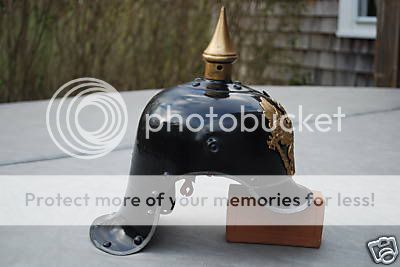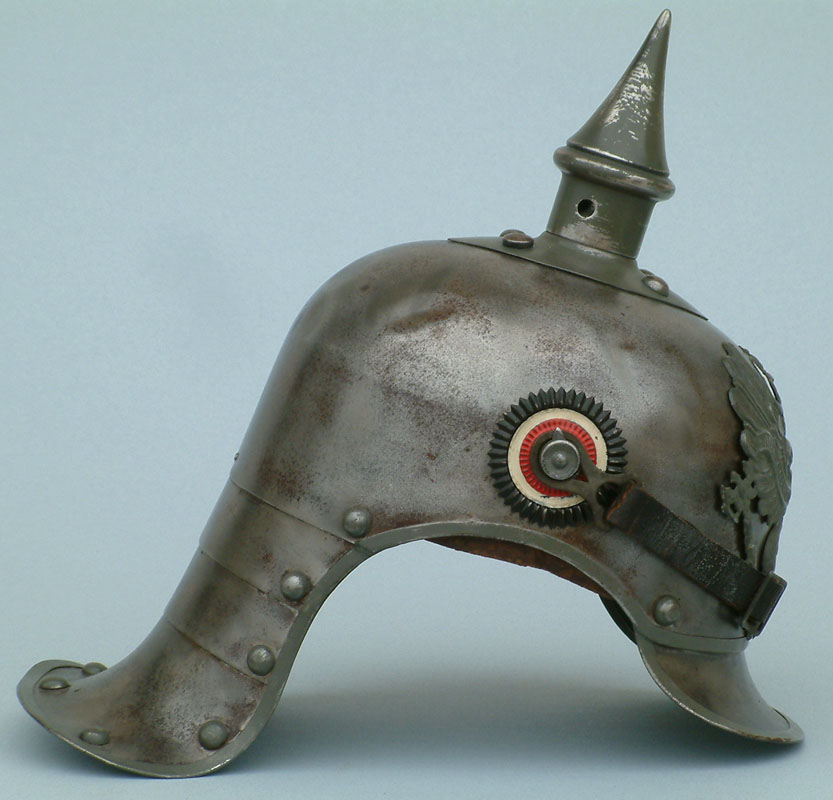USMC-EOD
Active member
Hi Gents.
I got lucky on Ebay and bought a pretty cool M-1915 Lachmann cuirassier helmet for a good price. Unfortunately (fortunately???) the previous owner had painted the entire exterior of the shell black and painted the wappen and removable spike gold. I could tell from the pictures in the ad that the liner appeared to be in good shape and the trim still was gray in color-a good sign. I think the paint kept the bidding low, but I was still pretty surprised when I won, considering what these things are going for these days.
If I had been smart last weekend, I would have taken some before and after photos while I was cleaning it up. However, the helmet as I got it can be seen if you type in Ebay item number 130302848317.
I think the paint actually protected the finish on the shell and all other parts before I removed it. An observation I made concerning this helmet was that the liner retaining brads are actually braised onto the sides rather than being separate pieces like on my M-1915 C.E. Junker and Damaschke cuirassier helmets. The wappen and edge trim appears to be gray parkerized, as are the spike base and rivets. The spike is painted a gray-green color like Tony reported on an earlier thread concerning this manufacturer.
I have attached a few pictures of the cleaned-up helmet and one picture of my Damaschke M-1915 helmet next to it to show the cotrast between the two types of manufacturing styles. Please forgive my photography; if I could only handle a camera as readily as my issued weapon!
I also included a shot of a couple of leather wappen wedges which fit together perfectly and have a manufacturers' stamp on the back side. I thought they were interesting and something which I have never seen a manufacturer do before in my other enlisted helmets. I would be interested in finding out if anyone else has ever seen this before?
R/S
Bryan.





I got lucky on Ebay and bought a pretty cool M-1915 Lachmann cuirassier helmet for a good price. Unfortunately (fortunately???) the previous owner had painted the entire exterior of the shell black and painted the wappen and removable spike gold. I could tell from the pictures in the ad that the liner appeared to be in good shape and the trim still was gray in color-a good sign. I think the paint kept the bidding low, but I was still pretty surprised when I won, considering what these things are going for these days.
If I had been smart last weekend, I would have taken some before and after photos while I was cleaning it up. However, the helmet as I got it can be seen if you type in Ebay item number 130302848317.
I think the paint actually protected the finish on the shell and all other parts before I removed it. An observation I made concerning this helmet was that the liner retaining brads are actually braised onto the sides rather than being separate pieces like on my M-1915 C.E. Junker and Damaschke cuirassier helmets. The wappen and edge trim appears to be gray parkerized, as are the spike base and rivets. The spike is painted a gray-green color like Tony reported on an earlier thread concerning this manufacturer.
I have attached a few pictures of the cleaned-up helmet and one picture of my Damaschke M-1915 helmet next to it to show the cotrast between the two types of manufacturing styles. Please forgive my photography; if I could only handle a camera as readily as my issued weapon!
I also included a shot of a couple of leather wappen wedges which fit together perfectly and have a manufacturers' stamp on the back side. I thought they were interesting and something which I have never seen a manufacturer do before in my other enlisted helmets. I would be interested in finding out if anyone else has ever seen this before?
R/S
Bryan.









